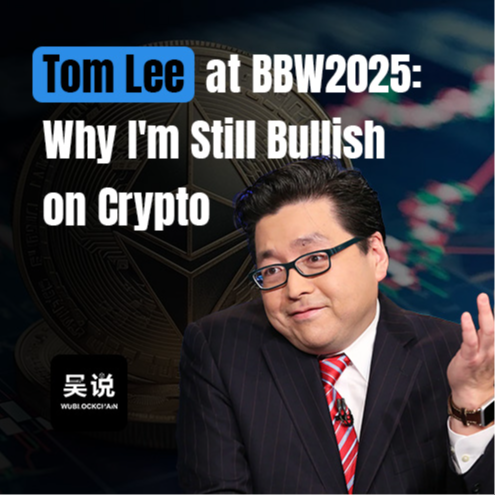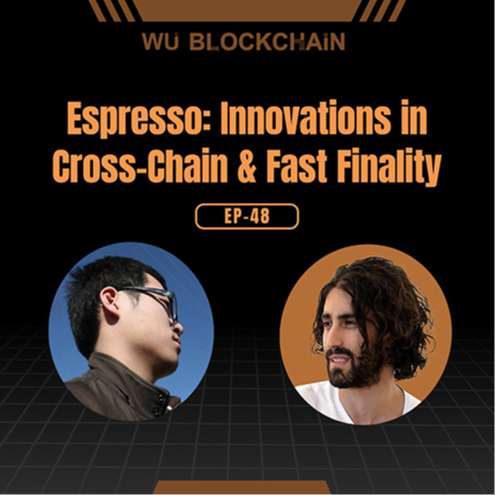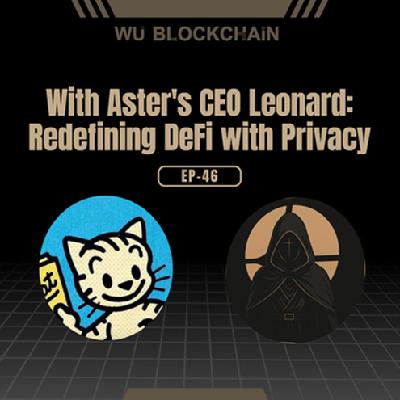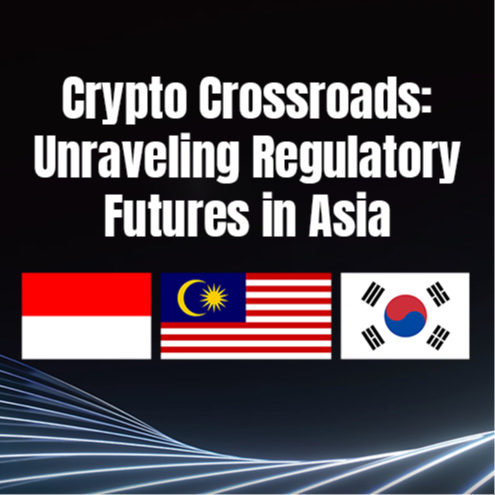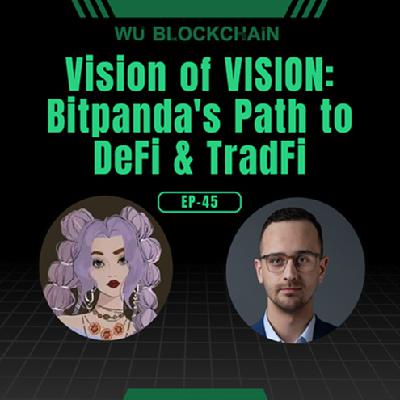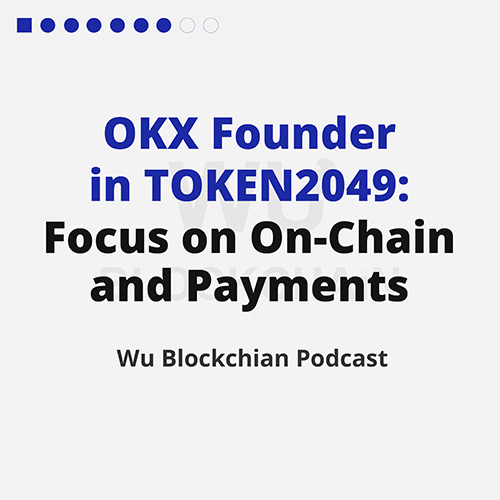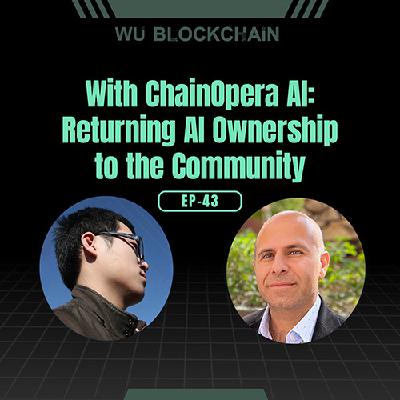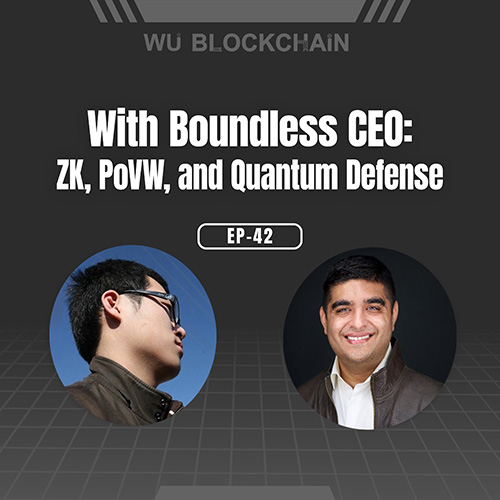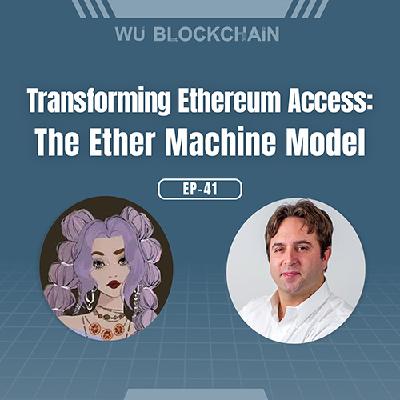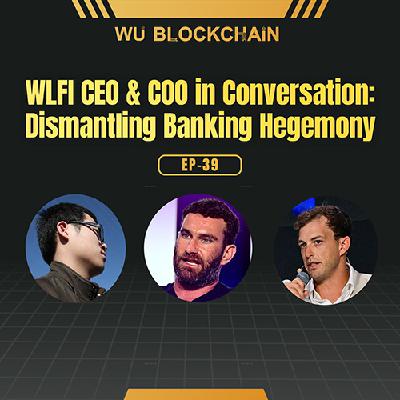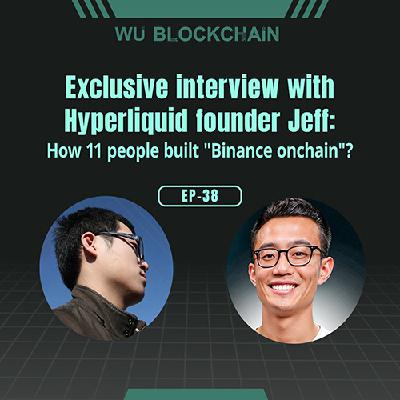Discover WuBlockchain Podcast
WuBlockchain Podcast

WuBlockchain Podcast
Author: WuBlockchain Podcast
Subscribed: 5Played: 9Subscribe
Share
© WuBlockchain Podcast@小宇宙App
Description
A podcast from professional media brand WuBlockchain that discusses and analyzes important news in the crypto world, with a special focus on Asia. https://twitter.com/WuBlockchain
57 Episodes
Reverse
At Binance Blockchain Week 2025, held on December 3–4 in Dubai, Tom Lee-Co-founder of Fundstrat and Chairman of BitMine-delivered a keynote titled "The Crypto Supercycle Intact." In his speech, he systematically outlined his long-term bullish thesis on the crypto market. His core arguments included: why tokenization is the defining theme of 2025; why he believes Bitcoin and Ethereum have already bottomed; how the traditional four-year cycle is being disrupted; why Ethereum is positioned as foundational infrastructure for the future global financial system; and why Digital Asset Treasury (DAT) companies will play a critical role in the next phase of crypto financialization.Tom Lee argues that Bitcoin's cyclical logic is being reshaped by industrial and inflation cycles, rather than the familiar four-year halving pattern. On tokenization, he emphasizes that the true transformation goes far beyond simple "digitization of assets." In his view, the future of finance involves deep financial decomposition and reconstruction, where stocks, cash-flow streams, product lines, and even the implied economic value of a CEO can be fragmented, priced, and tokenized-enhancing transparency, predictive power, and hedging efficiency across capital markets. He also describes how BitMine, as a representative DAT, aims to serve as a bridge between Wall Street and the crypto ecosystem.Timeline:00:00 Context of the speech: Tom Lee's professional roles and why he addresses crypto amid a market pullback01:36 Five themes overview: tokenization, market cycles, Ethereum, institutional opportunity, and digital asset treasury companies02:53 Reviewing a decade of asset performance: why crypto remains the strongest asset class03:55 Major positive developments in 2025: policy support and institutional adoption05:39 Tokenization becomes the core narrative of 2025: Ethereum's "ChatGPT moment"06:36 Long-term growth potential: adoption remains extremely low07:46 Assessing the market bottom: mispricing, deleveraging, and structural changes08:26 Discussion of Bitcoin's drawdown: is the four-year cycle still valid?09:36 Fundstrat model adjustments: incorporating Tom DeMark's timing indicators11:22 Dissecting the Bitcoin four-year cycle: why it may be breaking down13:40 Price implications: if the cycle breaks, Bitcoin could set new highs in January14:10 Why Ethereum is the future financial infrastructure15:41 Continued Ethereum upgrades: reinforcing its ecosystem position16:27 ETH/BTC valuation breakout: structural repricing ahead17:39 The true value of tokenization: from digitization to financial decomposition19:56 Prediction markets + tokenization: a new architecture for capital markets21:18 Strategic role of DATs in bridging TradFi and DeFi
In this interview, Ben Fisch, the founder of Espresso, elaborates on the project's technological innovations aimed at solving the fragmentation problem in Web3 blockchain ecosystems. Espresso seeks to address these challenges by offering high-speed finality and supporting Layer 2 technologies, facilitating efficient communication between different blockchains. Ben details how the project leverages improvements in consensus mechanisms and innovative technologies, such as erasure coding and zero-knowledge proofs, to reduce cross-chain latency and improve interchain interaction. He also discusses Espresso's appeal to top developers and investors, as well as its future market positioning and tokenomics model. Timeline:00:00 Origins of Espresso and Its Initial Goals 03:07 The Impact of AI and Crypto Talent Competition 04:17 The Causes of Web3 Fragmentation 08:07 Why Digital Finance in Web3 is Still Fragmented 08:37 Espresso's Technological Innovations and How It Differs from Traditional Blockchains 09:00 The Advantages of Espresso in Supporting Layer 2 and Its Performance Features 10:16 How Espresso Solves Cross-Chain Interaction and Finality Issues 12:33 Espresso's Consensus Mechanism and Cross-Chain Communication 15:08 Espresso's Consensus Design and Achieving Fast Finality 18:21 How Espresso Uses Zero-Knowledge Proofs for Real-Time Cross-Chain Communication 20:55 How Espresso Supports Multi-Chain Ecosystems and Bridges to Other Chains 21:23 The Benefits of Espresso for Rollup Projects 23:32 Rollups' Demand for Espresso and Use Cases 24:46 The Value of Espresso's Token and Network Effects 26:28 Reasons for Introducing the Token and Future Value Drivers 29:43 Espresso's Future Vision and Market Positioning
At Binance Blockchain Week 2025, held in Dubai on December 3–4, Binance founder CZ participated in a group media interview. The Q&A covered topics such as crypto payments, digital asset treasuries, U.S. policy shifts, Giggle Academy, life perspectives, and more.CZ emphasized that payments remain crypto's biggest unresolved challenge, that successful Web3 founders must be product- and user-driven with long-term focus, and that while the DAT model is viable, its risk depends on management. He noted that renewed U.S. regulatory openness will unlock major opportunities, mainstream adoption requires regulatory clarity, infrastructure and enterprise integration, crypto is already improving financial access in developing countries, and education, philanthropy, and ecosystem development will be his personal priorities going forward. Timeline:00:00 Why Crypto Still Hasn't Solved Payments02:44 Binance's Early Vision, Organizational Evolution, and Regulatory Dynamics04:04 What Makes Founders Survive the Next Cycle: Product Focus & Long-Termism05:18 CZ on Life, Uncertainty, and What Truly Matters07:17 Sustainability and Risk Profile of the Digital Asset Treasury (DAT) Model10:33 After the Trump Pardon: Will the US Become a Core Crypto Market?12:53 How CZ Maintains Mental Health Amid Media Pressure16:22 Keys to Mainstream Adoption: Regulatory Clarity & Financial Integration19:51 How Crypto Brings Real Value to Emerging Markets23:15 Giggle Academy: Education Mission, Content Expansion & Community Funding26:52 CZ's Philanthropy Priorities and Social Impact Projects30:50 When a Billion People Use Web3: Abstraction & the Future of UX33:11 Binance's New Leadership Structure & CZ's Future Focus37:28 Daily Habits Behind CZ's Success: Learning & Staying Healthy
At Binance Blockchain Week 2025, Binance founder CZ and Euro Pacific Asset Management CEO & Global Strategist Peter Schiff engage in a fiery debate over the value and future of Bitcoin versus tokenized gold. Peter argues that tokenized gold, backed by tangible reserves, offers superior stability and real-world utility. CZ counters that Bitcoin, as a decentralized and borderless digital asset, carries unique technological advantages and growing global demand despite volatility. The two clash on payment use cases, investment value, technical foundations, and long-term prospects, ultimately holding firm to their opposing views.Timeline:00:00 Peter explains the practical use and value backing of tokenized gold04:16 Peter argues Bitcoin is like fiat money with no backing05:34 CZ presents physical gold on stage and raises the issue of verifiability09:03 CZ: Bitcoin, like the internet, is intangible yet still valuable11:45 Peter emphasizes Bitcoin has "no real utility," therefore no intrinsic value13:44 Peter explains why gold can serve as a central bank reserve asset17:12 Debate on whether Bitcoin qualifies as "money"22:29 CZ highlights Bitcoin's utility in payments and as a store of value25:25 Peter claims Bitcoin resembles a Ponzi structure27:01 Peter: Despite major tailwinds, Bitcoin's price has fallen over the past four years31:05 Peter argues Bitcoin's wealth effect comes from wealth transfer33:04 CZ shares a real example of how Bitcoin improved a user's life in Africa36:31 Debate over whether crypto payment cards actually use crypto for payments42:00 Dispute over whether Bitcoin can store value45:55 Discussion on whether speculators dominate Bitcoin's price49:25 Peter reiterates Bitcoin is purely speculative and lacks real value54:00 Debate concludes: both sides firmly maintain their positions
In this episode of the WuBlockchain Podcast, Rand Hindi, CEO of Zama, explores the transformative potential of Fully Homomorphic Encryption (FHE) in blockchain. He highlights its critical role in ensuring privacy while maintaining scalability. Zama's protocol adds a confidentiality layer to existing blockchains like Ethereum and Solana, enabling secure transactions. Hindi explains how FHE stands out from other privacy technologies such as Zero-Knowledge (ZK) proofs and Multi-Party Computation (MPC), especially in enabling confidential token transfers and DeFi applications. He also discusses Zama's progress and its upcoming token auction.Timeline:00:00 Introduction to Zama and CEO Rand Hindi's background01:27 Why privacy is becoming a critical issue for AI and blockchain technologies02:50 Explanation of FHE vs. other privacy technologies05:46 How Zama uses FHE, MPC, and ZK together to enable confidentiality on existing blockchains07:41 Integration of Zama's privacy layer with EVM-compatible blockchains09:12 Developer ease in building encrypted smart contracts on Zama's protocol10:35 Overcoming the historical challenges of FHE, including scalability and cost12:08 Zama's progress in solving compute problems and scaling FHE to Ethereum-level speeds12:47 The current technical bottleneck: hardware advancements needed for faster computation13:51 Forecast on achieving real-time encrypted computation14:28 Ensuring compliance and auditability in private computations using Zama16:10 The impact of FHE on MEV and blockchain fairness17:10 Expected use cases for FHE in crypto, such as confidential payments and token distribution19:30 Example of confidential token distribution and its importance for privacy20:40 Zama's approach to encrypted auctions for token sales23:34 Unique decentralized applications made possible only by FHE25:22 FHE's role in solving trust issues with AI agents in financial decisions28:11 Zama's team and investors, including the company's research-heavy background and funding30:34 Balancing research and execution in a decentralized, remote working environment32:54 Upcoming events: Zama's mainnet launch and token auction
In this episode, Leonard, CEO of Aster, discusses his career journey from traditional finance to the world of decentralized finance (DeFi) and the role Aster plays in the evolving crypto ecosystem. He shares insights into the competitive landscape with projects like HyperLiquid, Aster's unique product features, and its community engagement approach. Leonard also talks about the development of privacy-focused blockchain infrastructure, Aster's roadmap, and his views on the broader market trends affecting Web3 and cryptocurrencies.Timeline: 00:00 Transition from TradFi to DeFi: Leonard's Early Career05:28 Collaborating with CZ: How Trust Was Built10:16 Aster's Competitive Edge: Differentiation from HyperLiquid13:02 Multi-Chain Integration and Decentralized Trading Experience17:02 Privacy-Focused Blockchain: Aster's Vision for Privacy in Trading18:03 Aster's Token Airdrop Program: Enhancing Community Engagement and Utility19:18 The Roadmap: Infrastructure, Token Utility, and Privacy Solutions27:50 Focus on AI for Improving User Experience in DeFi33:11 DeFi Users' Concerns and Aster's Trust-Building Strategy40:23 Market Outlook: The Importance of Survival and Positive Cash Flow
This episode features a fireside talk from the Finternet 2025 Asia Digital Finance Summit, themed "Asia's Crypto Frontier: Balancing Regulation and Compliant Growth". The session was moderated by Angelina Kwan, Managing Director of Stratford Finance, and featured speakers Wong Huei Ching, Executive Director of Digital Strategy and Innovation at the Securities Commission Malaysia; Uli Agustina, Director of Digital Financial Assets and Crypto Assets Supervision at Otoritas Jasa Keuangan (Indonesia Financial Services Authority); and Harry Kim, Chief Business Officer at Kintsugi Technologies. The Finternet 2025 summit took place on 4 November in Hong Kong under the theme "Connecting Dreams × Building the Future,"supported by more than ten institutions including OSL Group, Invest HK, the Financial Services Development Council and Hong Kong Cyberport.Timeline:00:00 Introduction and framing: Asia's regulatory leadership in crypto02:34 Korea pushes for ETPs, catching up with Hong Kong05:02 Korea's phased legislation: exchanges, custodians, stablecoins07:24 Malaysia pushes institutionalization and bank-crypto collaboration10:27 Tokenization sandbox initiatives in Malaysia13:36 Indonesia's clearinghouse and custodian setup16:09 Real-world use cases: cattle tracking, property tokenization18:52 Perpetuals and ETPs: regulated exchanges entering the space23:21 Korea's tax and custodian regulations still evolving24:49 Malaysia's custodian licensing regime and bank involvement26:57 Indonesia's 2026 focus: derivatives regulation, innovation sandbox30:36 Korea eyes more institutional participation with regulation
This episode features a fireside talk from the Finternet 2025 Asia Digital Finance Summit, themed "Hong Kong's Breakthroughs, Innovation and Safeguarding". The session was moderated by Gary Tiu (Executive Director, Head of Regulatory Affairs, OSL Group), with guest Eric Yip (Executive Director, Intermediaries Department, SFC Hong Kong). Text summary.The Finternet 2025 summit took place on 4 November in Hong Kong under the theme "Connecting Dreams × Building the Future," supported by more than ten institutions including OSL Group, Invest HK, the Financial Services Development Council and Hong Kong Cyberport.On 3 November, the SFC issued a circular allowing licensed local Virtual Asset Trading Platforms to share order‑books with affiliated overseas platforms -- meaning Hong Kong investors will soon be able to trade into the same liquidity pool as overseas markets, directly accessing deeper liquidity and closer to international pricing.Timeline:00:00 Philosophy and Challenges of Crypto Regulation in Hong Kong03:47 Balancing Regulatory Rules and Principles06:21 Differences Between Banking and Regulatory Mindsets09:30 Progress and Goals of SFC Policies in 202310:35 Progress and Challenges of Regulatory Frameworks11:55 Promoting Rapid Innovation and Licensing Programs14:17 The "Quick Failure" Mechanism in Regulation16:00 Trial-and-Error Challenges and Strategies in Policy Making18:11 Product Innovation and Development Expectations
This episode features a fireside talk from the Finternet 2025 Asia Digital Finance Summit, themed "From Hong Kong to the Middle East: The Evolution of Digital Assets Regulation". The session was moderated by Rocky Tung (Director, Policy Research & Specialist Advisor, Financial Services Development Council, Hong Kong), with guests Elizabeth Wong (Director of Intermediaries & Head of FinTech, Securities and Futures Commission, Hong Kong) and Wai Lum Kwok (Senior Executive Director, Financial Services Regulatory Authority, Abu Dhabi Global Market). Text summary.The Finternet 2025 summit took place on 4 November in Hong Kong under the theme "Connecting Dreams × Building the Future," supported by more than ten institutions including OSL Group, Invest HK, the Financial Services Development Council and Hong Kong Cyberport.On 3 November, the SFC issued a circular allowing licensed local Virtual Asset Trading Platforms to share order‑books with affiliated overseas platforms -- meaning Hong Kong investors will soon be able to trade into the same liquidity pool as overseas markets, directly accessing deeper liquidity and closer to international pricing. Timeline:00:00 Introduction: Hong Kong Financial Services Development Council01:49 SFC's early regulatory experiences and developments04:08 Hong Kong's latest policy: Accessing global liquidity07:05 Changes in Abu Dhabi's regulatory framework08:39 The trend of integration between traditional finance and crypto markets10:40 Regulatory challenges in cross-border transactions and capital flows12:59 Tokenized assets and global regulatory alignment14:31 Progress in Hong Kong's digital asset ecosystem development15:06 The relationship between license approval processes and market development18:56 Interoperability and the integration of technology and regulation22:10 Practical applications and market feedback on tokenized assets
In this episode, Georg Hahn, Delivery and Execution Lead for Bitpanda's Web3 projects, discusses the Vision ecosystem and how Bitpanda is bridging traditional finance (TradFi) and decentralized finance (DeFi). Georg explains how the Vision token powers Bitpanda's Web3 infrastructure -- a suite of products empowering both retail and institutional users -- with a focus on tokenomics, governance, and partnerships.Bitpanda is a cryptocurrency trading platform that provides user brokerage services for Bitcoin and other digital assets. It has a wallet and trading platform, enabling users to buy and sell cryptocurrencies using Euro, credit cards, Skrill, SEPA transfers, and other methods.Timeline: 00:00 Introduction and Background04:25 The Vision Ecosystem at Bitpanda08:39 Pillars of the Vision Ecosystem12:38 Comparing Vision to Other Tokens18:37 Strategic Partnership with SG Forge20:30 Strategic Goal Behind Bringing SG Forge Stablecoins Directly On-Chain22:02 Balancing Innovation and Compliance25:32 The Future of European Exchanges in Web328:48 Competition vs Collaboration Among European Platforms30:21 Vision Ecosystem's Global Expansion: Focus on Asia34:58 Europe's Web3 Identity: Compliance and Long-Term Sustainability39:11 Vision's Path Forward
In this in-depth interview, Deribit CEO Luuk Strijers shares insights into the company's journey from a niche crypto options platform to a leader in institutional trading. Deribit is currently the largest cryptocurrency options exchange. Its BTC options trading volume accounts for over 80% of the total market, while ETH options make up more than 90% of the total ETH options market volume.Luuk highlights Deribit's early entry, product specialization, and robust infrastructure as key advantages over multi-product competitors like Binance. Luuk details the reasoning behind Deribit's acquisition by Coinbase, citing strategic alignment and expanded global reach. He addresses regulatory challenges, especially KYC complexities, and emphasizes a continued institutional focus. Luuk also shares thoughts on DeFi competitors, expansion plans, product development (including smaller contracts and longer-dated options), and Deribit's vision as Coinbase's international options arm. Text summary.Timeline:00:00 Luuk's Background and Journey into Crypto02:20 Why Deribit Dominates Crypto Options Despite Big Exchange Competition05:20 Product Depth vs. Liquidity vs. Trust: What Drives Deribit's Market Leadership07:25 Coinbase Acquisition: Why Deribit Chose to Sell and Future Synergies10:05 Addressing KYC Complaints and Future Compliance Under Coinbase13:55 Will Deribit Ban Users from China or Hong Kong Post-Acquisition?14:20 Can On-Chain Platforms Like Hyperliquid Challenge Centralized Exchanges?18:00 Strategic Focus: Deribit's Roadmap After Joining Coinbase20:12 Role of Asia in Deribit's Future Growth20:55 Team Size and Culture: Deribit vs. Coinbase Workforce22:10 Biggest Challenges as CEO and Core Competitive Edge in One Sentence24:25 On Competing with IBIT and Market Share Impacts27:53 Expanding Beyond BTC/ETH: Will Deribit Add More Assets Like Gold?31:14 Linear Contracts and Smaller Sizes to Increase Accessibility32:20 Demand for Long-Dated Options (LEAPs) and RFQ-Based Solutions33:27 Institutional Strategy and Why Coinbase-Style Culture Matters
This episode features two segments from OKX Founder and CEO Star Xu at the TOKEN2049 conference: a keynote speech and a fireside chat. The audio content is in English.In his keynote, Star Xu reflected on the evolution of the crypto industry over the twelve years since OKX was founded, highlighting Bitcoin and stablecoins as two major milestones. He contrasted traditional finance, which he described as a "closed system," with DeFi as an "open system." He emphasized that the future of finance will be built on transparent, interoperable, and global on-chain infrastructure, enabling full tokenization of assets and payments.In the fireside chat, Star Xu focused on the rollout and vision of OKX's payment product, OKX Pay. He revisited the rise of Bitcoin and stablecoins, stating that stablecoins are poised to become the core infrastructure of future payments -- enabling low-cost, cross-border, peer-to-peer transactions, while also exceeding traditional banks in terms of security and compliance.Timeline:Keynote Speech by Star Xu00:00 Bitcoin and stablecoins as the foundation of the crypto industry01:08 The transparency and globalization of DeFi02:51 Self-custody and compliance empower users to regain control04:42 OKX builds real-time on-chain monitoring and global compliance framework05:30 X Layer and OKX Vision Fund support the on-chain financial ecosystemFireside Chat06:30 How crypto payments can integrate into daily life08:40 Stablecoins as the future infrastructure for cross-border payments10:01 How OKX Pay differs from and improves on traditional credit card payments12:38 How on-chain payments enable yield generation for users14:49 OKX as a liquidity hub for stablecoins15:32 Why OKX chose a hybrid "self-custody + compliance" model16:00 Multi-signature security to protect user funds16:40 X Layer as the global infrastructure powering OKX Pay
The episode of the WuBlockchain Podcast features an interview with Salman Avestimehr, Co-Founder of ChainOpera, for an in-depth discussion on building an AI-agent and model network through community co-creation and co-ownership. Focusing on the intersection of AI and blockchain, the conversation examined how decentralized AI can impact people's lives—much as the internet once brought individuals closer together—by enabling humans to interface more easily with complex ecosystems, giving individuals a degree of agency when facing large centralized systems, and allowing everyone to participate, co-create, and co-own.Timeline:00:00 Founding catalyst for ChainOpera02:22 What is ChainOpera AI's mission?03:50 What problems is "decentralized AI" meant to solve?06:15 Team composition and roles08:54 What do "Crypto GPT/Crypto AGI" signify?12:06 Where do AI and blockchain best intersect?16:57 How does ChainOpera AI differ from peer projects?18:45 User base and activity metrics20:25 Four-layer architecture and division of responsibilities22:31 Ecosystem progress23:45 How will AI agents evolve?29:33 Next-step roadmap
This episode of the Wu Blockchain podcast features an interview with Boundless CEO Shiv Shankar and RISC Zero Head of Global Marketing Tina Liu, focusing on the Boundless mainnet, the step-change in ZK proof performance, and token economics. Boundless, introduced by RISC Zero, is The Verifiable Compute Layer built in Rust. It provides a componentized stack that simplifies ZK integration, performing computation off-chain while using ZKPs on-chain for cross-chain interactions, batching proofs from heterogeneous systems to reduce on-chain verification costs and improve developer efficiency.Key takeaways: ZK has moved from a "research topic" to mass production, with applications compressing Ethereum block-level (single-block) proofs to ~12 seconds. Boundless achieved decentralization on day one, distributing rewards by contribution via Proof of Verifiable Work (PoVW)—emphasizing "more work, more pay" and non-forgability—to avoid single-point oligopolies. During the public test phase, the mainnet exhibited a Jevons effect: lower costs expanded usage. The project positions itself as the operations and distribution layer for ZK compute, expanding demand through collaborations with Stellar, Base, and EigenLayer. It also stresses the post-quantum advantages of ZK—especially the STARK family—and counters compute monopolies with open bidding and a cloud price cap.Timeline:00:00 Why can Ethereum block-level proofs be compressed to ~12 seconds?03:46 How to balance high-yield narratives with token stability?04:15 Why insist on day-one decentralization?04:47 How does PoVW measure contribution and prevent forged work? Why call it an evolution of PoW?08:34 How does borderless mining attract new classes of compute providers?09:28 Why did a misunderstanding arise around the Kaito airdrop?11:02 Demand-side uplift driven by partner networks16:19 Cost-down applications for extreme workloads19:17 When proof costs fall, the Jevons effect emerges20:24 How do ZK and AI combine?25:07 How to address quantum threats?27:08 How to prevent compute oligopolies?29:06 What are the strategies for China and Korea?37:26 Pathways for government–public chain cooperation on post-quantum security38:22 Closing & next steps
In this episode, Andrew Keys, co-founder of The Ether Machine, outlines the company's novel strategy of offering institutional investors exposure to Ethereum through a public vehicle. Unlike traditional ETFs, The Ether Machine aims to generate additional yield for shareholders by actively staking, restaking, and participating in decentralized finance (DeFi). Andrew highlights how the company's clean corporate structure and its focus on Ethereum set it apart from other crypto asset management vehicles.Timeline:00:00 Introduction to Andrew Keys and The Ether Machine02:27 Transitioning from Consensus and DARMA to The Ether Machine03:44 The Ether Machine's $654 Million Raise and Treasury Model05:41 Why Ethereum Over Bitcoin for Asset Management07:09 Key Drivers Behind the Treasury-Centric Model09:09 The Ether Machine vs. Traditional Holding Companies and ETFs10:31 Explaining NAV (Net Asset Value) and its Importance12:09 NAV and its Role in Equity Valuation13:24 How Staking and Yield Generation Shape The Ether Machine's Business15:41 Communicating the Model to Traditional Market Investors16:40 Future Plans: Restaking and Advanced Yield Strategies17:16 Why The Ether Machine Chose SPAC over Direct Listing18:43 Advantages of a SPAC in the Crypto Regulatory Landscape20:15 Capital Structure Design to Avoid Dilution21:36 Ensuring Long-Term Sustainability for The Ether Machine's Model22:22 Balancing Institutional Interest with Ethereum's Native Values23:55 Educating Wall Street and Main Street on Ethereum25:33 Differentiating The Ether Machine's Strategy from Competitors27:22 Vision for Ethereum's Future in Finance28:31 Merging DeFi and TradFi: The Future of Finance29:06 SEC Compliance and Legal Clarity in The Ether Machine's Operation30:33 Regulatory Challenges and Expanding to Other Assets31:36 The Potential of Tokenization and Governance Layers for The Ether Machine32:04 Closing Thoughts on The Ether Machine's Future and Ethereum's Role
In this episode, Tong Pow, co-founder of Hologram (Creators of Holoworld AI and Ava Studio), talks about the evolution of Holoworld AI from its early NFT avatar experiments to becoming a platform that bridges AI and Web3. Tong explains how products like Hologram Extension, Agent Creator, and Ava Studio led to the launch of Hololaunch, a Launchpad designed to help both Web2 and Web3 IPs enter the blockchain space. He discusses Hologram's differentiation in the competitive Launchpad landscape, the roles of Holo and AVA tokens, and the ways AI-powered content creation can amplify community engagement. Tong also shares insights on partnerships, ecosystem growth, and the upcoming HOLO TGE. Text summary.Shownotes:00:00 Origins of Holoworld AI and Tong's AI + Crypto Journey02:09 AI's natural intersection with crypto and NFTs as virtual personas03:37 Evolution of Holoworld AI Products: Extension, Agent Creator, Ava Studio, and Hololaunch07:00 Current strategy and expanding to an agentic IP ecosystem07:59 Why Holoworld AI Built a Launchpad and User-Driven Demand09:00 Competitive landscape of Launchpads and Holo's positioning10:46 Trends in AI + on-chain Launchpad evolution11:51 Differentiation through technology, partnerships, and network effects13:04 Role of HOLO token in Hololaunch and ecosystem flywheels14:31 Distinction between HOLO token (ecosystem) and AVA token (app-level utility)16:42 Ava Studio's advantages over Runway, Pika, and others18:18 Open beta status of Ava Studio and mobile-first approach19:16 APIs and SDKs on the roadmap for pro creators20:01 New workflows vs. traditional production pipelines20:44 Combining Ava Studio with Hololaunch for creator-driven promotion21:45 Agent creation and no-code launch stack integration22:17 Incentive alignment across users, creators, developers, and investors23:52 Partnerships with Pudgy Penguins and upcoming collaborations24:45 Upcoming Holo TGE and opportunities for creators and stakers
This interview with WLFI co-founder Zach Witkoff and WLFI COO, co-founder Zak Folkman examines World Liberty's origins; the growth and applications of the USD1 stablecoin; plans for RWA tokenization; team structure and capital deployment; and the company's approach to regulatory engagement and regional market development. Zak stated that their goal is to serve user groups underserved by traditional finance through an integrated application--remittances, spending, crypto trading, and card payments--built around the USD1 stablecoin.Zach Witkoff emphasized that there is no equity or formal partnership with Binance, and the demand for USD1 on the BNB Chain is primarily driven by the market itself. He also mentioned facilitating a $2 billion cross-border settlement and noted that ALT5 Sigma plans to acquire $1.5 billion in WLFI tokens to support the ecosystem. The team operates with a lean but efficient configuration of about 30 members. On the policy front, Zach believes the new regulations provide clearer rules for the U.S. industry and will focus on expanding the community and activities in Asia, including in regions like Hong Kong, South Korea, and Singapore. Text summaryTimeline:00:00 Reason for Entering the Industry and Zach's Personal Background02:12 The Origins and Early Development of the World Liberty Project06:14 How World Liberty Helps Users Without Bank Accounts10:06 Misunderstanding About USD1 Stablecoin's Partnership with Binance13:43 How the World Liberty Team Advances Their Work15:55 How ALT5 Sigma Helps the World Liberty Ecosystem17:31 What Positive Impact Will Trump's Policies Have on the Entire Crypto Industry20:05 Will World Liberty Hold More Activities or Community Building in Asia
Hyperliquid is one of the most successful projects in this cycle. With a team of only 11 people, it has already captured more than 75% of the decentralized perpetual market share, with user assets reaching approximately US$6.2 billion. The project token market value is nearly US$16 billion, ranking 13th. It is even considered by the community to be the next Binance.In this episode, Jeff Yan, the founder of Hyperliquid, shares insights into the journey of building the decentralized Layer 1 blockchain. He discusses the importance of self-funding, rejecting venture capital, and the focus on user-driven growth. Jeff explains Hyperliquid's vision for a decentralized financial future, the rationale behind not pursuing token listings on centralized exchanges, and Hyperliquid Labs’ commitment to a small, efficient team. He also offers his perspective on the future of crypto startups, leadership in the crypto space, and how cultural values play a role in his approach to business. Text summary.Timeline:00:00 Introduction and Jeff's Background03:45 Jeff's Early Days in Building Hyperliquid and Its Success05:18 Why Hyperliquid Was Self-Funded08:10 Not Listing on Centralized Exchanges09:57 Advice for Crypto Startups: Funding and Listing Strategies11:37 The Role of Market Makers in Hyperliquid's Development13:19 Hyperliquid's Core Team and Hiring Strategy14:23 Future Team Growth and Vision15:46 Investing in Ecosystem Projects17:04 Hyperliquid's Roadmap18:59 Hyperliquid's Role in the Future of Decentralized Finance21:18 Hyperliquid's Success Compared to Larger Teams22:53 Jeff's Management Style and Leadership23:29 Leadership Philosophy and Importance of Team Dynamics25:33 Advice for Entrepreneurs in the Crypto Space28:21 Jeff on His Cultural Background and Its Impact on Hyperliquid32:19 Jeff's Message to the Chinese Community
In this podcast episode, Valentin Gui, General Manager of xStocks at Kraken, discusses the potential of equity tokenization, differentiating from competitors like Robinhood, navigating regulatory hurdles, and future expansion plans. xStocks aims to provide global users, especially those without direct equity access, with synthetic exposure to stocks through fully collateralized tokens. Valentin emphasizes the platform's permissionless, multi-chain capabilities, its inclusive partnership model, and long-term ambitions to become a foundational infrastructure for Web3 financial systems. Text summary.Timeline:00:00 Opening00:43 Clarifying xStocks' Connection to Previous Ventures and Ensuring Token Collateralization02:16 Why xStocks Chose Stock Tokenization: Expanding Financial Inclusion through Synthetic Equity Exposure03:20 How Kraken's Interest in RWAs and Strategic Partnerships Accelerated xStocks' Adoption05:57 Differentiating xStocks from Robinhood through Permissionless, Multi-chain Tokens07:11 Competitive Strategy: Welcoming Binance and Coinbase as Potential Partners07:57 Addressing Liquidity Challenges across Centralized and Decentralized Exchanges09:24 Regulatory Challenges and Strategy: How xStocks Avoids the Pitfalls Faced by FTX and Binance in the U.S.10:17 Impact of SEC's Regulatory Approach on Tokenized Securities and xStocks' EU Launch via Cyprus Entity11:21 Major Regulatory Hurdles: Educating Regulators on Classifying Tokenized Equities12:22 Exploring Opportunities in Tokenizing Pre-IPO Equity12:42 xStocks' 2025 Roadmap: Geographic Expansion, Increased Token Utility, and Scaling Offerings13:57 The Potential of Perpetual Contracts and Derivatives on Tokenized Stocks14:17 Growth Outlook: Significant Expansion Anticipated due to Global Demand15:06 Collaboration with Gate.io and Potential Partnerships including Hyperliquid15:51 Discussing Potential Collaboration with Trump Family Projects16:19 IPO versus Token Issuance: Backed's Potential Path Forward16:44 Could Tokenized Equities Replace Traditional Stocks?17:51 Expanding beyond US Equities: Prospects for Tokenizing Hong Kong and Chinese Stocks18:26 Building a Cross-chain Ecosystem for Tokenized Stocks and Enhancing Utility19:42 Accessibility as the Main Driver for Mass Adoption of Tokenized Equities21:09 Long-term Vision: Positioning xStocks as Financial Infrastructure Rather than Just a Retail Product22:36 Misconceptions about Market Potential and Global Demand for Tokenized Stocks
In this episode of WuBlockchain Podcast, Sam MacPherson, co-founder of Phoenix Labs, shares how Spark has evolved from a DeFi lending protocol into a capital allocator managing nearly $4B across DeFi, CeFi, and RWA. He explains the Spark Liquidity Layer's role in optimizing yield--especially through tokenized U.S. Treasuries--while maintaining a 25% cash reserve to ensure stability. Sam discusses the platform's modular governance via the Sky-Star system, its push into the APAC market, and the upcoming SPK token launch for staking and governance. Transparency and on-chain auditability remain Spark's core strengths over traditional finance. Text summaryTimeline:00:00 Opening & Brief Intro01:40 Transition from Lending Protocol to Diversified Capital Allocator03:26 Strategic Logic Behind the $1 Billion Tokenized Treasury Deployment04:36 Market Conditions That Informed Timing of RWA Investment06:06 Reconciling DeFi Decentralization with Centralized Custodians07:48 Target Return Profile and Outperforming Treasury Yields08:55 Reinvesting in Existing Treasury Partners and Negotiated Fees09:30 Partner Selection Via Tokenization Grant Competition10:28 Role of Tokenized Treasuries in Yield Stabilization11:11 Competitive Advantage: Trust, Scale, and On-Chain Transparency12:47 Liquidity Layer's Operation and Ecosystem Integrations14:58 Managing Risk and Maintaining Yield Stability with High Cash Reserves16:39 Protocol Resilience During Historical Market Crashes17:38 Regulatory Compliance in RWA Interface and Protocol Design18:51 Next RWA Target: Investment-Grade Corporate Debt20:03 Community Outreach and Expansion Strategy in APAC20:55 Modular Star System for Fast Governance and Scaling22:23 Adapting to Macro Trends Like U.S. Interest Rate Shifts23:47 Upcoming SPK Token Launch and Governance Utility


